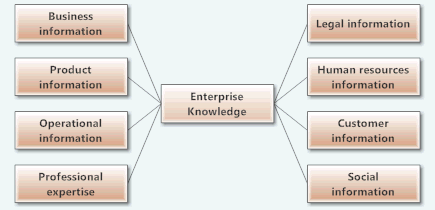
Overview of Knowledge Management
The idea behind knowledge management is deceptively straightforward. The aim is to ensure that the best available information and most appropriate intellectual assets of an organization are available to the right people at the right time.
The process of managing information touches every aspect how an organization works and understands itself. The mind map below presents some of the common types of information that can be found in a moderate sized organization.

Helping to manage the complexity around the different information types, is a wide range of information systems and "solutions"
- Business Information Management Systems (BIMs)
- Product Information Management Systems (PIMs)
- Customer Relationship Management Systems (CRMs
- Content Management Systems (CMS)
- Human Resource Management Systems
... the list goes on.
Common Knowledge Management Solutions
At a deep level and regardless of how well any one system might perform, all of these systems are developed along the same basic lines. They are database systems with metadata and relational structures designed to address a specific range of use cases.
The key idea behind these systems is that they are "solutions," meaning integrated platforms for handling specific classes of information objects. These systems claim to manage information based on their ability to capture, search, report, provide workflows, and deliver information based both rules and operational control tasks.
The systems common to most organizations are grounded in relational database management systems. Interactions with these systems are through user interfaces or through connectors in a way that allow the system to operate as a service across an enterprise network. Private network service-orient architecture (SOA) operates inside the corporate firewall but use many of the same technologies at work on the Internet.
In these systems, the metadata schemes are proprietary but usually require customizations to meet organizational requirements. The internal taxonomies are not friendly to human users. Input value vocabularies and rules, and other human design elements, along with other functional elements require mapping for both system input and information delivery.
Essential to the success of these systems is the establishment of defined processes for managing service oriented architecture, internal metadata scheme, and the various vocabularies involved in these systems. The label typically given to such processes is "governance."
The large volume of enterprise information, so-called "Big Data," and the expense of maintaining software and databases are driving a further evolution of these systems to cloud based services that rely alternatives to in-house relational databases, either in hybrid from, as graph databases, or as NoSQL database approaches. Marketed on Software as a Service (SaaS) model, these systems live outside the enterprise behind secure servers and accessed through the Internet.
Emerging Knowledge Management Solutions
Emerging knowledge management technologies present number of unique challenges. Among the most profound are metadata and governance. Architecturally, these systems do not use data tables with well-defined columns and rows. Relationships between data elements are not described in terms of entity relationship diagrams. Indeed, the distinction between the functional code and data itself melts away. Scripted operations and algorithmic storage structures manages system processes across a very large array of servers, which act as repositories. Server mapping and access are managed through one of a number of intermediary service layer architecture.
This is desirable because of the very large scale of the information being passed renders more standard approaches unworkable.
On the other hand, this approach places a premium on incorporating metadata definitions, enterprise and customer vocabulary and other taxonomy based-concerns deep within information architecture of the development process. The higher-level notion of governance as it might relate to the application development process has not received the same level of attention as it has received in other information technology areas.
Semantic Knowledge Management
Finally, neither the common nor the emerging knowledge management technologies are interoperable beyond themselves. By being unable to easily talk to or understand other information systems, they are at best, platform applications that do not share or reuse either data or taxonomy and the semantics it provides.
As such, these systems do not support the notion of there being a single best source of truth, and in certain respects multiple the number of data instances, with the corresponding risks to data hygiene of asynchronous data stores.
To link data and achieve semantic interoperability requires advanced taxonomy analysis and development. The rigorous technology is increasingly available for creating a standards driven approach to authentic knowledge management.